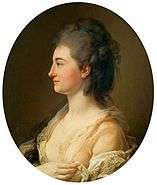Królikarnia
| Królikarnia The Rabbit House | |
|---|---|
|
Main façade. | |
| General information | |
| Architectural style | Neoclassical |
| Town or city | Warsaw |
| Country | Poland |
| Construction started | 1782 |
| Completed | 1786 |
| Demolished | 1944 |
| Client | Charles Thomatis |
| Design and construction | |
| Architect | Domenico Merlini |
Królikarnia (English: The Rabbit House) is a historic palace in Warsaw, Poland in the classical style, as well as a neighborhood in the Mokotów district of Warsaw. A museum dedicated to Polish sculptor and artist Xawery Dunikowski has been located in the palace since 1965.[1]
History

The palace is named for its former role as a rabbit warren for King Augustus II the Strong.[2] Królikarnia was erected for the King's Theatre Entrepreneur and Chamberlain - Charles Thomatis, Count de Valéry by Royal architect Domenico Merlini on the picturesque Vistula escarpment. The palace was built between 1782 and 1786.[1] It was modelled on the famous renaissance Villa Rotonda outside Vicenza, designed by Andrea Palladio. In his estate, the count established a brewery, a brickyard, an inn, a mill, a barn and a garden with vineyard. Controversially Thomatis was also described as a pimp for King Stanisław August Poniatowski, whose "villa at Królikarnia was little more than a high-class brothel".[3]
In 1794, during the Kościuszko Uprising, the insurrection's leader Tadeusz Kosciuszko resided in the palace. In 1816 the estate was purchased by Michał Hieronim Radziwiłł, and in 1849 by Ksawery Pusłowski, a passionate collector of art. A few years later in 1879 the palace was partially destroyed by fire, and shortly afterwards rebuilt by Józef Huss for the Pusłowski family.
Królikarnia was completely destroyed during extensive bombardments by the Germans in 1939 and 1944.[1] The palace, intended to house the collection of sculptures by Xawery Dunikowski, was reconstructed in 1964.[1]
References
- 1 2 3 4 "Królikarnia". www.krolikarnia.mnw.art.pl. Retrieved 2008-07-24.
- ↑ Tadeusz Jaroszewski. "Księga Pałaców Warszawy. Pałac Królikarnia". kmk.waw.pl (in Polish). Retrieved 2008-07-24.
- ↑ Mary Lindemann (2006). Liaisons dangereuses: sex, law, and diplomacy in the age of Frederick the Great. JHU Press. p. 239. ISBN 0-8018-8317-2.
External links
![]() Media related to Królikarnia Palace at Wikimedia Commons
Media related to Królikarnia Palace at Wikimedia Commons
Coordinates: 52°11′20.4″N 21°1′42.5″E / 52.189000°N 21.028472°E
.jpg)